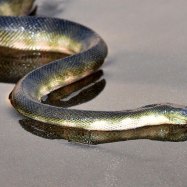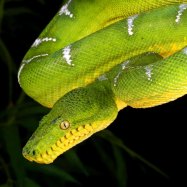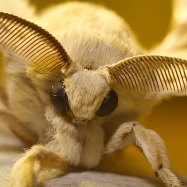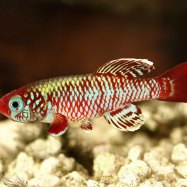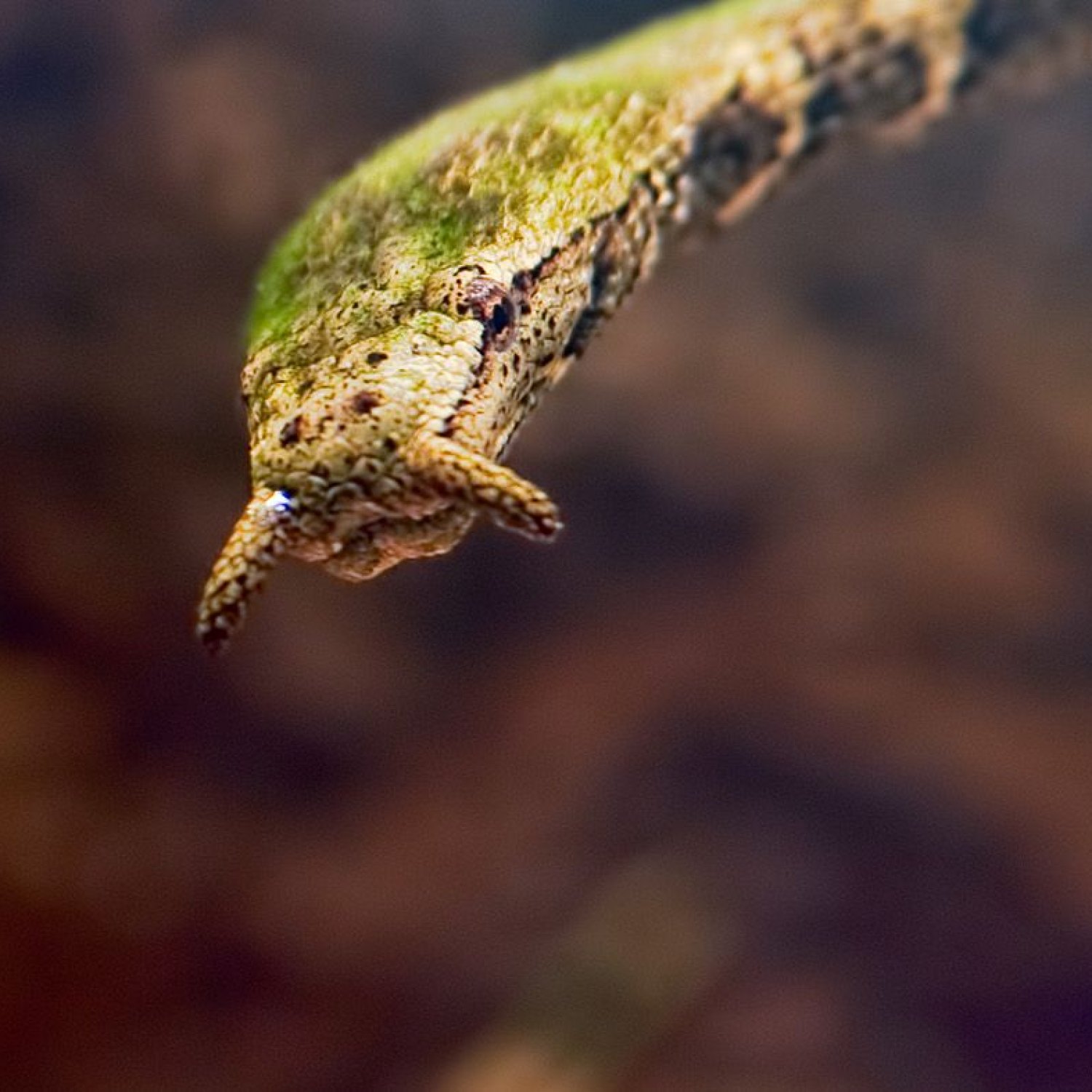
Tentacled Snake
60 - 90 cm
The tentacled snake, known for its unique hunting technique, can be found in water bodies with dense vegetation. With a length of 60-90 cm, this slender and cylindrical snake belongs to the family Colubridae. Admire this creature's camouflage skills and agile movements in its natural habitat.
Animal Details Summary:
Common Name: Tentacled Snake
Kingdom: Animalia
Habitat: Freshwater rivers, streams, and marshes
The Mysterious Tentacled Snake: A Unique Reptile from Southeast Asia
At first glance, the tentacled snake may look like any other snake found in Southeast Asia. With its grey or brown coloration and slender body, it may not immediately stand out among other reptiles in the region. However, upon closer inspection, one will notice the unique feature that gives this snake its name – two long tentacles located on its snout.Scientifically known as Erpeton tentaculatum, this species belongs to the class Reptilia, making it a close relative of other well-known reptiles such as crocodiles, lizards, and turtles Tentacled Snake. Its common name, tentacled snake, refers to the two tentacle-like appendages found on its upper jaw. These tentacles are used by the snake to sense its surroundings and prey in the water, making it an extraordinary creature to study.
Found in countries such as Indonesia, Thailand, Cambodia, Laos, Vietnam, Malaysia, and Singapore, the tentacled snake can be spotted in freshwater rivers, streams, and marshes, as these are its preferred habitats. It is also commonly found in water bodies with dense vegetation, as this provides the snake with ample hiding spots and prey.
Feeding on fish and other aquatic creatures, the tentacled snake is a carnivorous species. Its hunting technique is unlike any other snake, as it does not chase its prey or ambush it like a predator. Instead, it uses its unique snout tentacles to detect vibrations in the water caused by swimming fish. Once it has located its prey, it coils its body and launches itself towards the unsuspecting fish, caught off guard by this surprising attack.
The tentacled snake's unique feeding method is made possible by its anatomy and body shape Taco Terrier. Unlike other snakes, this species has a more cylindrical body, allowing it to move with ease in the water. Its scales also differ from other snakes, as they are smaller and smoother, providing less resistance while swimming.
On average, the tentacled snake measures around 60-90 cm in length, making it a rather small reptile compared to its larger cousins in the region. It has a lifespan of 4-5 years, which is relatively short compared to other reptiles. However, despite its short lifespan, this snake has managed to survive and thrive in its natural habitat, fascining researchers and nature enthusiasts alike.
One of the most intriguing things about the tentacled snake is its ability to adapt to its environment and fool its prey. With its grey or brown coloration, it seamlessly blends into the muddy waters, making it almost invisible to passing fish. Its dark blotches further add to its camouflage, making it one of nature's most effective ambush predators.
Over the years, researchers have been fascinated by this mysterious snake and have conducted various studies to better understand its unique features and behaviors. One study by Kenneth Kardong and DeAndria Presnell of Washington State University focused on the tentacled snake's ability to strike from any angle and any position, making it highly efficient in catching its prey. They also observed how the snake's snout tentacles played a crucial role in its hunting success, with even a slight disturbance to the water causing the snake to immediately strike towards the source of the disturbance.
Another study by Dr. Kenneth Catania of Vanderbilt University delved into the remarkable sensory capabilities of the tentacled snake. By using high-speed cameras and special sensors, Dr. Catania and his team were able to capture the exact movements of the snake's tentacles and how they detect and analyze prey signals. The study found that the tentacled snake's tentacles are highly sensitive to vibrations in the water, enabling the snake to detect even the slightest movement from its prey.
Aside from its unique hunting and sensory capabilities, the tentacled snake also exhibits interesting behavior and defense mechanisms. When threatened, this snake is known to flip its head and tail, forming a circle, in an attempt to intimidate its predator. This strange behavior has led to its other common name, the "cerberus snake," after the mythological creature with three heads. It also has the ability to remain completely still, with only its tentacles moving, to avoid detection from potential prey.
Despite its intriguing features and abilities, the tentacled snake is facing several threats in the wild. The destruction of its natural habitat due to human activities, such as pollution and deforestation, has greatly affected the population of this unique reptile. Additionally, it is also hunted and captured for trade and the pet industry, causing further decline in its numbers.
To help conserve this fascinating species, efforts are being made to raise awareness about its importance in the ecosystem and to protect its natural habitats. Researchers are also working towards understanding the tentacled snake's behavior and biology in hopes of implementing effective conservation strategies.
In conclusion, the tentacled snake is a truly remarkable and mysterious creature found in Southeast Asia's murky water bodies. Its unique features, behavior, and abilities make it a fascinating subject for researchers and nature enthusiasts. However, it is also a species facing numerous threats, making conservation efforts crucial in ensuring its survival for future generations to study and appreciate.

Tentacled Snake
Animal Details Tentacled Snake - Scientific Name: Erpeton tentaculatum
- Category: Animals T
- Scientific Name: Erpeton tentaculatum
- Common Name: Tentacled Snake
- Kingdom: Animalia
- Phylum: Chordata
- Class: Reptilia
- Order: Squamata
- Family: Colubridae
- Habitat: Freshwater rivers, streams, and marshes
- Feeding Method: Carnivorous
- Geographical Distribution: Southeast Asia
- Country of Origin: Indonesia, Thailand, Cambodia, Laos, Vietnam, Malaysia, Singapore
- Location: Water bodies with dense vegetation
- Animal Coloration: Grey or brown with dark blotches
- Body Shape: Slender and cylindrical
- Length: 60 - 90 cm
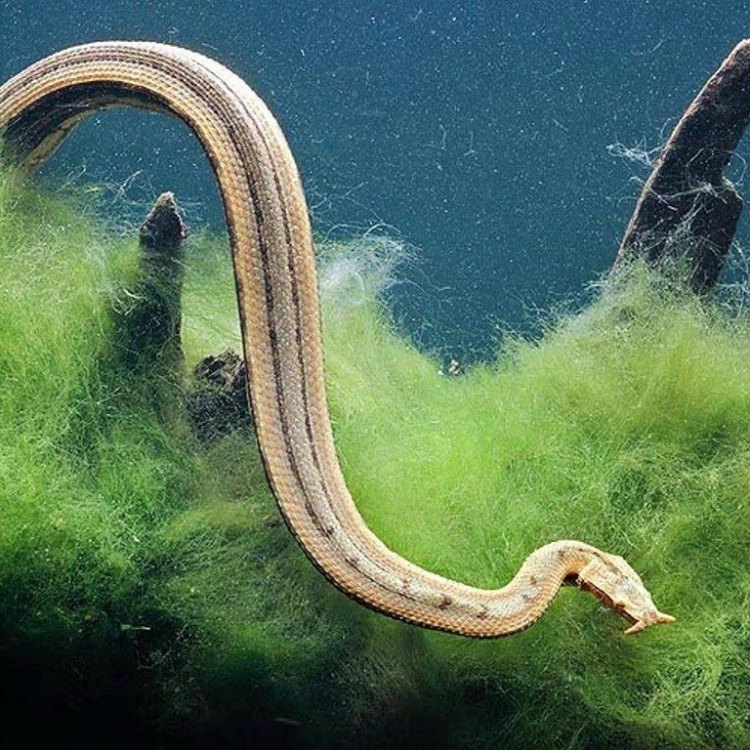
Tentacled Snake
- Adult Size: Up to 90 cm
- Average Lifespan: 10 - 15 years
- Reproduction: Oviparous (lays eggs)
- Reproductive Behavior: Mates in water
- Sound or Call: Hissing sound when threatened
- Migration Pattern: Non-migratory
- Social Groups: Solitary
- Behavior: Ambush predator, spends most of its time hidden in vegetation
- Threats: Habitat destruction and pollution
- Conservation Status: Least Concern
- Impact on Ecosystem: Helps control aquatic populations of fish and amphibians
- Human Use: None
- Distinctive Features: Pair of tentacles on its snout
- Interesting Facts: Can hold its breath for up to 30 minutes
- Predator: Large fish, birds
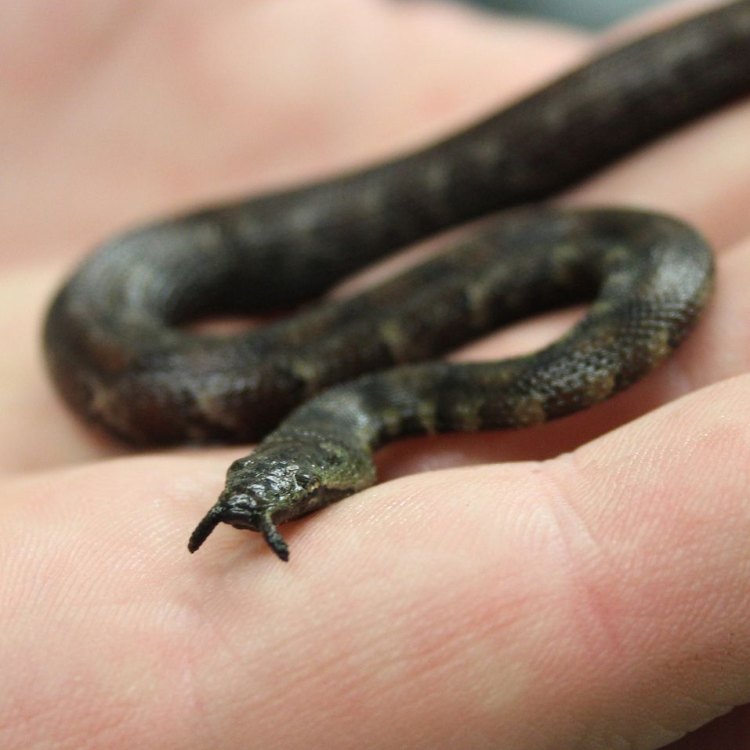
Erpeton tentaculatum
The Enigmatic Tentacled Snake: Nature's Master of Deception
As we delve into the depths of the natural world, we come across countless creatures that leave us in awe with their unique and often bizarre features. From the colorful chameleon to the majestic peacock, the animal kingdom has no shortage of fascinating organisms. Among these mysterious creatures is the tentacled snake, a master of deception and adaptation found in the freshwater bodies of Southeast Asia.The tentacled snake, also known as the Erpeton tentaculatum, is a non-venomous aquatic snake species native to the rivers and lakes of Thailand, Cambodia, Vietnam, and Laos PeaceOfAnimals.Com. What sets this snake apart from its counterparts is its distinctive pair of tentacles on its snout, which give it its name. These tentacles, which are extensions of the snake's nasal cavity, are used as sensory organs to detect vibrations in the water, helping the snake in hunting and navigation.
One of the most intriguing aspects of the tentacled snake is its appearance. It can grow up to 90 cm in length, with a slender body and light brown coloration. However, its small size and dull color do not make it any less fascinating. The unique feature of the snake's tentacles makes it stand out from other snakes and adds to its mysterious charm.
On average, the tentacled snake has a lifespan of 10-15 years, with some captive individuals living up to 20 years. It is an oviparous species, meaning they lay eggs instead of giving birth to live young. These eggs are typically laid in the early days of the rainy season, between April to June, and hatch after approximately two months Timor Python.
When it comes to reproductive behavior, the tentacled snake has some unconventional habits. Unlike many snakes, which mate on land, these snakes prefer to mate in the water. The male snake coils its body around the female, and they move in synchronized motions, resembling a dance. This unique underwater courtship ritual is a sight to behold and can last for several hours.
Aside from its reproductive behavior, the tentacled snake also has a distinct call or sound. When threatened, these secretive creatures produce a hissing sound, similar to that of a cat, to deter potential predators. This hissing sound, coupled with their elusive nature, makes them challenging to spot in the wild.
Speaking of the wild, the tentacled snake is known to be a non-migratory species, meaning it does not undertake long-distance movements or seasonal migrations. Instead, it is a solitary creature that spends most of its time hidden in vegetation, waiting for its prey to come to them.
Like all snakes, the tentacled snake is a predator at heart. However, it has some unique predatory behaviors that contribute to its deceptive nature. The snake is an ambush predator, patiently waiting for its prey to swim by before striking with lightning-fast reflexes. Its slender body and smooth scales, coupled with its slow movements, make it difficult for potential prey to detect its presence until it is too late.
The tentacled snake's diet primarily consists of fish and amphibians, with occasional reports of them consuming small mammals and crustaceans. They are skillful hunters, often targeting fish much larger than themselves. The snake's extraordinary hunting techniques and efficiency in catching prey have earned it the nickname "fishing snake."
However, the tentacled snake's role in its ecosystem extends beyond being a top predator. As an ambush predator, it helps regulate the populations of fish and aquatic amphibians in the water bodies it inhabits. This control is crucial in maintaining the balance of the aquatic ecosystem, ensuring other species do not overpopulate and disrupt the delicate equilibrium.
Unfortunately, like many other species, the tentacled snake is facing threats to its existence. The main threat to these snakes is habitat destruction and pollution. Due to human activities, the freshwater habitats these snakes inhabit are rapidly deteriorating, resulting in a decline in their population. It is a sad reality that many unique and vital species are at risk of extinction due to human actions.
Although the tentacled snake is currently classified as "Least Concern" on the IUCN Red List of Threatened Species, it is essential to monitor their populations and habitats closely. Without proper conservation efforts and protection of their environment, these snakes could soon become an endangered species, and their mesmerizing existence may disappear forever.
Now, you might be wondering, are there any human uses for the tentacled snake? Well, the good news is, there are none. These snakes are not venomous, and their meat is not considered palatable, making them of little interest for human consumption. Additionally, they do not have any significant economic importance, making them a non-target species for hunting or harvesting.
In conclusion, the tentacled snake is a captivating and enigmatic creature that continues to baffle researchers and enthusiasts alike. Its distinct features, unique behaviors, and crucial role in its ecosystem make it a species that demands our attention and conservation efforts. Let us hope that with proper awareness and protection, we can ensure the survival of this mysterious and fascinating species for generations to come. And who knows, there might be more secrets and surprises waiting to be discovered in the depths of the natural world.
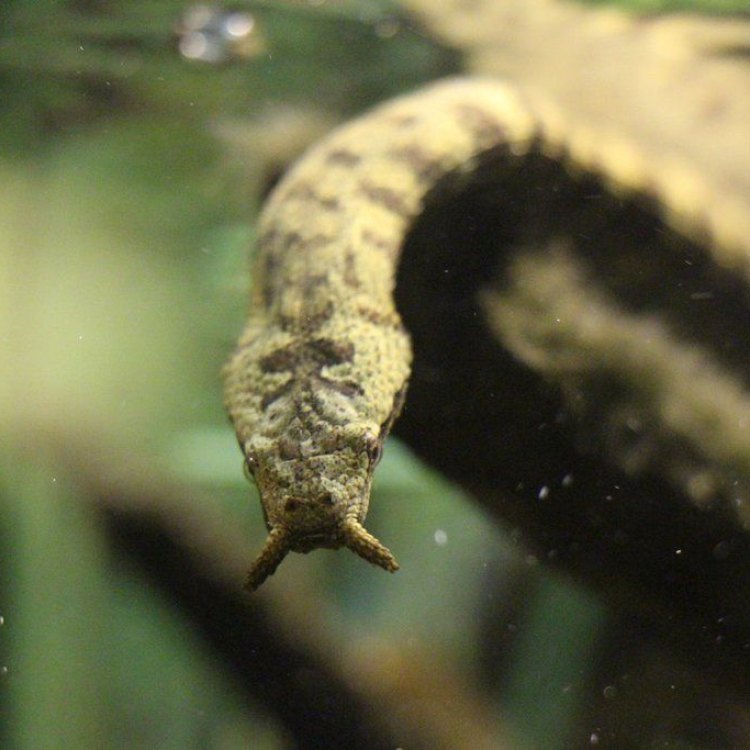
The Mysterious Tentacled Snake: A Unique Reptile from Southeast Asia
Disclaimer: The content provided is for informational purposes only. We cannot guarantee the accuracy of the information on this page 100%. All information provided here may change without prior notice.

